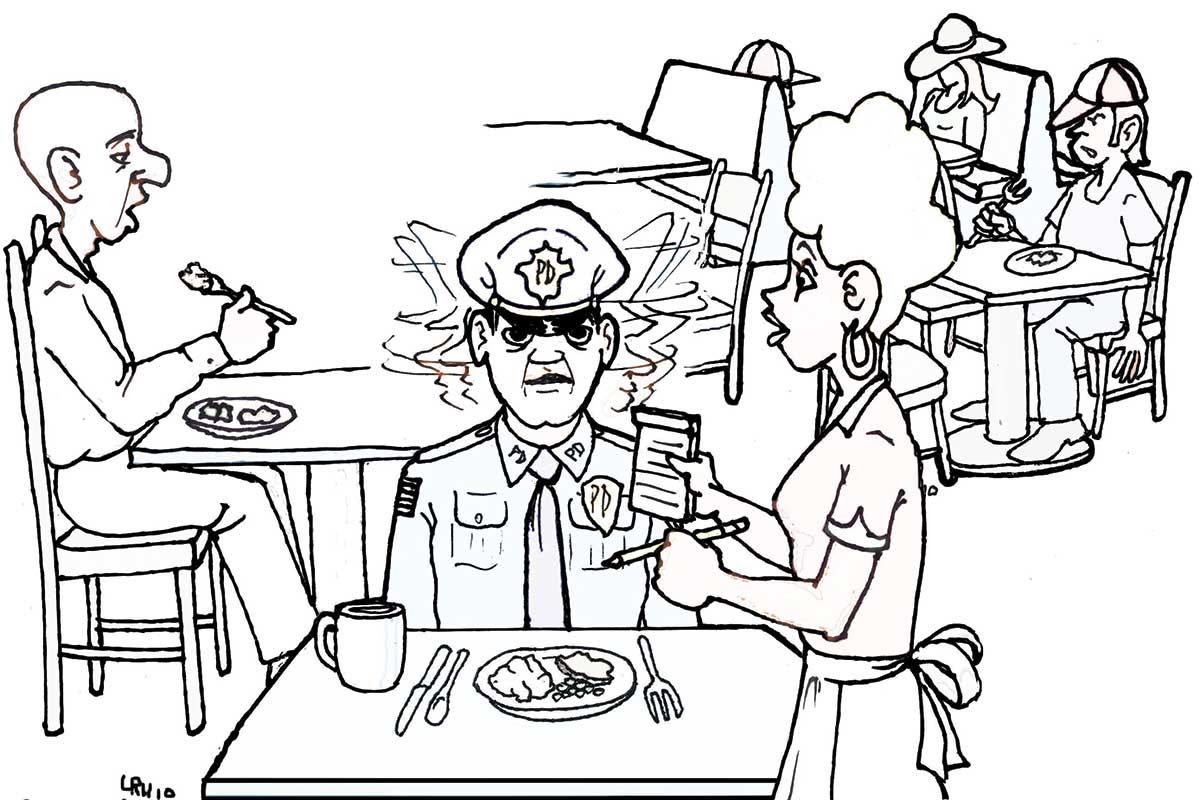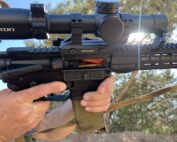
ACMJ10_B&W-cafe-800
My partner and I were working the graveyard shift and had taken a coffee break in a restaurant. We were engaged in an intense discussion about something so important I can’t remember what it was, when from my left side I felt a hand touch my shoulder and voice say, “Excuse me, officer.” Startled, I quickly turned to address this unknown potential threat and came face to face with a little old lady wanting directions. Where the heck did she come from? How did I miss her? Worse yet, how did my partner miss her when he was facing her approach?
When we went through the academy, officer survival was pounded into our heads on a daily basis. We were taught to be aware of our surroundings at all times, look at anything and everyone we came in contact with, to trust our instincts and not much else — to never let our guard down. But some-where along the way we became complacent. Some more than others, but all of us are guilty of it to some extent. I’d love to say with my time on SWAT and my continued years as a firearms trainer I’m immune to this and am ever-vigilant. However, I’ll fall on my sword and be the first to admit, I too am at fault here. If any of you are reading this and thinking, “Not me, I’m always ready,” I applaud you. But if you’ve ever been on duty having coffee with a partner and been surprised by someone walking up to ask you a question, then read on.
COMFORT = COMPLACENCY
Situational awareness is nothing new. We’ve had it taught to us, we’ve taught it to others and we try to live it. So where do we go wrong?
First and foremost we must remember we’re human and as humans we’re prone to mistakes. It’s difficult to do something consistently, without a break or an error. Unfortunately it only takes one mistake of not being aware of your surroundings to cost you your life. Second, we’re creatures of habit and this alone breeds complacency. When you go to the same coffee shop, sit in the same booth and talk to the same waitress, this gives you a sense of comfort. This comfort can be the root of complacency. When we’re comfortable we assume everything is going to be okay, just as it’s always been. But you know what they about people who assume …
As you go through your daily routine, pay attention to how many things you do on autopilot, such as leaving your house, driving to work, maybe getting gas on the way and then walking into the station. Maybe (hopefully) when you go into service and hit the street your awareness level raises. You probably have a work version of autopilot, like when you go into the not-so-nice neighborhood and are ready for action. This version of autopilot you learned through training, therefore you should be able to train yourself to maintain a work-like autopilot mode in your life outside of the job.
PAY ATTENTION
You need to have a plan for your daily life. Every waking moment you should be in condition yellow, relaxed but aware of your surroundings — even at home. As you leave the house begin paying closer attention, looking around more and actually seeing things. Don’t think just because you don’t have the uniform on you’re not a target. If you’re out with your family, make sure you’ve discussed ahead of time what to do in various situations. Many officers talk to their family about what they should do if something major goes down, but have you talked to them about the more mundane things like not mentioning your profession in public or mixed company? I remember the first time my then 4-year-old daughter yelled out, “My daddy’s a police officer!” Yes, she was proud, but we were in a crowded public place and I felt a little exposed.
When you’re on-duty do a better job of observing your surroundings, especially when taking a break in a public place. Take your breaks with a partner and plan who’s responsible for watching, and in which direction. Make sure to sit at tables and in chairs that give you a tactical advantage. I regularly avoid places where armed chairs are available because it’s difficult to quickly get out of the chair, let alone grab my gun.
Some agencies have policies limiting breaks to only two officers at one location. Usually this policy is simply to keep the public happy; it looks tacky to have an entire squad hanging out at the same spot. You could argue the more of us together then the more of us vulnerable to an attack, a la Lakewood, Oregon. I say it’s actually safer since there are more eyes and more guns — but — those eyes must be watching and those guns must be ready. If a bad guy wants to kill a cop, and is willing to do so regardless of risk, then it’s probably going to happen. We aren’t hard to find; it’s one of the risks of the job. If they’re dumb enough to attempt it, let’s try to make ‘em pay for it.














